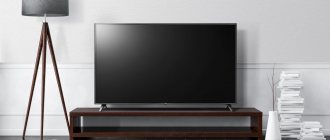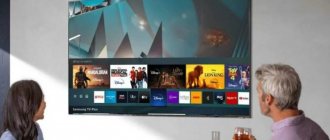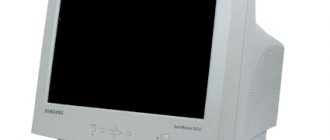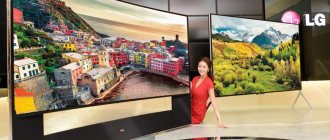In Russia, the very name “projection TV” is not very common, not to mention the device itself. Although this technology was used in the middle of the last century. It was used in television receivers, in which the image was broadcast using cathode ray tubes. This review will tell you how this technique works and what types of it are presented on the modern market.
History of projection televisions
Over the entire period of its existence, the technology has passed through the peak of popularity to its almost complete extinction. The very first TVs with projectors had a lot of disadvantages:
- poor viewing angle;
- low quality screen backlight;
- Not a good level of contrast and brightness.
Therefore, it is not surprising that with the advent of modern LED TVs, projection models almost completely ceased to be in demand.
Soviet projection TV
However, with the advent of high-definition HDTV channels, the need arose to display high-quality images on widescreen TVs. Projection models have begun to gain popularity again. The technology used to create them has become most popular in TVs with a diagonal of 50 inches or more. As it turns out, high-quality images have become cost-effective on projection TVs.
In Western Europe, Japan and the USA, the real popularity of new technologies came at the end of the 2000s, when there was a boom in the purchase of projection TVs. Gradually, cheaper flat-panel LCD and plasma TVs entered the electronics market, and large projection models quickly began to lose their popularity.
Since Russia is somewhat behind progressive countries in the field of high-definition television technologies, it is impossible to find projection televisions on official sale. However, some connoisseurs of modern and unusual devices order them through online stores.
Varieties of projection methods
To provide projection, two main methods are used:
- electron beam;
- liquid crystal.
In the first option, CRT tubes are used, through which weak light is transmitted. This design is very massive, and the output is a “modest” picture, not only in terms of design, but also in brightness. The best result was achieved using a lamp for a projection TV with a liquid crystal matrix. In this case, LCD technologies are used. In some models, the image is passed through several matrices at once, and this improves the quality of the image. Recent developments use DLP light processing. For operation, micro-mirror matrices are used, as well as special sector filters. As a result of a combination of technologies, the output is a high-quality picture.
Features of projection TV
Image formation is based on the design features of projection devices: they contain special small projectors . They direct the image to the screen through a complex system of lenses and mirrors. In general terms, it looks like the video is being projected from a TV.
The main difference between projection models and standard TVs is that the video on them has very high brightness. And thanks to special optics, the image will not be blurry, regardless of resolution.
It is very easy to distinguish projection TVs from modern models - they are more similar to old devices, their thickness can reach 40 cm. This is due to the fact that there are a lot of different parts in the design of the equipment.
Image quality
The main problem with projectors has always been the image quality they were ultimately capable of, both in terms of contrast levels and color accuracy. The first indicator can become significantly worse due to ambient lighting or insufficient quality of the projection surface. However, it's also important to keep in mind that direct sunlight can create glare on your TV screen - which I'm sure you'll agree is much more annoying.
Yes, color accuracy for large projection displays is still a major challenge. LCD projectors usually do a much better job of getting the colors right, but they also tend to create a screen door effect, which is clearly demonstrated in the image above. DLP projectors use a special rotating wheel to create shades - they are devoid of both the disadvantages and advantages of the previous solution: they have noticeably less accurate colors, but the annoying inter-pixel distance is not visible.
Screen door effect is a visual artifact of displays where thin lines separating pixels or sub-pixels become visible in the displayed image. This can be seen in images from digital projectors and conventional displays when zoomed in or at close range. (Wikipedia)
LCD and LED TVs with large screens also have separate pixels. However, at this stage of technology development, manufacturers take into account the ratio of display dimensions and the number of dots on them, so that the latter have a minimum size. This is why the screen door effect does not occur until you view the picture from a distance of several centimeters. In ordinary life, nothing like this usually happens, so TV is much preferable in this regard.
Winner: In this round, the big screen TV wins - it handles colors much better and doesn't create the effect of a screen door.
Projection TV design
There are devices with front and rear projection (it should be noted that the production of the latter has been discontinued since 2014). The picture will begin to “emerge” in a small source using CRT tubes or an LCD display. Then, through a system of optical lenses, it is transmitted to the screen.
The device includes the following parts:
- projector with optical system;
- boards responsible for creating the original image;
- backlight;
- lenses and mirrors;
- cooling system.
Imaging type
In devices of this type there are three types of image formation. They divide the TVs themselves into the following groups:
- kinescope (CRT);
- liquid crystal display (LCD);
- on micromirrors (DLP);
- D-ILA (combination of LCD and DLP).
CRT
In the first option, there are at least three picture tubes with basic colors - each will form a picture in its own color scheme. It can be noted that the quality is high, but this technique also has significant drawbacks - areas of still images burn out, it has significant weight and dimensions.
LCD
An LCD projection TV produces an even higher-quality picture (before on-screen projection, light passes through liquid crystal matrices - from one to three). The big drawback is the likelihood of a pixel structure appearing. One of the most recent developments is LCoS - liquid crystals on silicon, which use a special matrix. This makes the image incredibly realistic.
DLP
The DLP system is recognized as the most modern. It is a chip in which millions of micromirrors are hidden. The number of chips varies from one to three. Needless to say, the screen displays a bright, high-quality and contrasting picture with high color rendition and clarity.
But even the most successful projection designs have some shortcomings. This is the so-called rainbow effect, which manifests itself in short-term flashes of green, red and blue flashes. This often happens when a bright object moves quickly against a dark background, or when the viewer's eyes move across the screen.
D-ILA
There is another type of image formation called Direct Drive Image Light Amplifier, which combines the capabilities of DLP and LCD technologies. The development belongs to the Japanese company JVC. It is based on the same LCD matrix as in LCD models, but the work here is based on reflection (similar to DLP). Technologically, it looks like this: the picture is formed by adding light fluxes coming from the three matrices of the device. The main feature of this idea is softness in color gradations and smoothed pixels (important for large-screen devices).
Recently, such projectors have lost their popularity, but now we can note a significant revival of this technique. It is promising in terms of the ratio of its “talents” and price. Users appreciate these devices for their short response time and the absence of many of the problems that are inherent in plasma and LCD counterparts.
Projectors and projection TVs
- History or how it all began
- Light valve projector
- Projection TVs and CRT projectors
- Projection TVs and projectors on LCD matrices
- Projection TVs and projectors on silicon substrate (LCOS)
The history of the emergence and creation of the first projection televisions dates back to a very, very long time ago, from the beginning of the 20th century. The first black and white TVs were, in fact, “projection”, here they are:
That’s right, it’s just that earlier, as you remember from the history of the creation of picture tubes, their length was quite considerable, therefore, so that the TVs did not take up half the room, the picture tubes in them were installed vertically, and they were viewed through the reflection in a mirror installed in the top hinged lid
Of course, you say, in this case, if you watch any TV in the reflection of a mirror, it immediately becomes a projection? However, this is exactly how it is. All CRT televisions are essentially projection, because electron beams “draw” an image on the screen (kinescope), but let’s go further and look at the first projection televisions produced in the USSR. They were not available for free sale; they were manufactured in small batches to order from organizations with 1951
of the year.
Here are the later models " Moscow
" and "
Topaz
" (1957-1961)
These “bedside tables”, with dimensions of about 1x0.5x0.5 meters, assembled in wooden cases, weighed about 70 kg and were designed for simultaneous viewing by 25-30 spectators. In addition to receiving television programs, they could receive radio stations or play records, had a strong sound system (up to 6 speakers) and a wired remote control
To ensure maximum image brightness, the projectors were equipped with an aluminum reflective screen in a frame with dimensions: 1045x1345x70 mm (1300x1060x130 mm) with two folding stands, which was installed 2.5 meters from the TV and weighed about 30 kg. The installation uses a 6LK1(B)
with an optical-mechanical system that allows you to project an image onto a screen in a quality in no way inferior to the quality of conventional CRT televisions of that time. Here's the inside view:
In the USSR, two models of color projection televisions were also released » Izumrud-201
" and "
Emerald-203
" (1959), but they did not find widespread use.
The image in them was formed by three different picture tubes (each giving its own color), and an optical-mechanical system combined three images into one (full-color) on a reflective screen. Model 201 was as huge as its black and white “brothers” (about 80 kg), but “ Emerald-203
” was a floor-mounted projection TV for personal use
The operation of the circuit was ensured by 36 radio tubes and 22 semiconductor diodes, and the image dimensions on the reflective screen were 350x460 mm (approximately 580 mm diagonally or 23 inches). Unfortunately, that’s all, but abroad, projection technology has continued and continues to develop
Light-valve projection devices on an oil film (with certain optical and electrical characteristics) modulated by an electron beam (Eidofor system) also deserve attention, because such a system made it possible to obtain an image measuring tens of square meters. Operating principle of the light valve device
was as follows: light from a powerful source with lens optics
1
ensuring uniformity of flow, falls on the slit mirror
2
and is reflected by it onto a spherical mirror
6
, covered with an oil film
7
.
The mirrors are oriented in such a way that, with a smooth film, the light, reflected, returns in the direction of the source, and screen 4
remains unexposed
Deformation of the film at any point causes the beam reflected from it to deflect, which, passing through the mirror slit 2
, hits a certain point on the screen using projection optics
3
.
The brightness of the spot on the screen depends on the deformation of the film, which, in turn, depends on the amount of charge installed on its surface by the electron beam. The electron gun 5
, which generates the electron beam, is enclosed in a glass shell common with the spherical mirror, in which a vacuum is maintained. The beam is focused, deflected by an electromagnetic system and modulated in power in the same way as in conventional CRTs (picture tubes). The main disadvantage is the production of oil, and replacing it (refilling from the reservoir) is not an easy procedure
Typically, these TVs are floor-standing devices, the lower part of which contains projection tubes with lenses, an acoustic system and electronics, and the upper part contains a mirror and a translucent screen. The image is formed as follows: from three very bright small picture tubes, light of primary colors ( RGB
) passes through a system of optical lenses, mirrors, prisms hidden in the TV body and is projected onto the screen. This leads to a significant increase in the image, which is displayed on a fairly large screen.
Tubes (picture tubes) have very high brightness
, therefore, it is not recommended to watch
motionless scenes
, since
the phosphor may burn out
and, as a result, the formation of stripes and contours that interfere with further viewing.
In addition, as a result of a significant increase in the image compared to the size of the kinescope, brightness is lost. They could only be viewed “straight on”, from the side or when exposed to bright light - viewing such systems was impossible. However, the color rendering quality was high, just like picture tubes recorded the picture constantly (in analog mode) and did not have a “grid”. The most common malfunction
is the lack of convergence of the rays, which can still be easily seen if you go into the hall of modern slot machines (simulators), at least one without convergence - but it will be there, and the picture with the red and blue colors crawling out on the sides is very reminiscent of the first 3D films
In this type of projectors and televisions, instead of three picture tubes, three matrices are used for primary colors (RGB - red, green and blue), followed by combining the three resulting images into one, or one RGB (three-color) matrix. The light is created by a powerful lamp, which requires constant heat dissipation (like the matrix), even after the projector has finished working, the built-in cooler (fan) still continues cooling for several minutes. A three-matrix system is characterized by optically dividing the light spectrum of a lamp into color components:
The light is polarized and passes through dichroic mirrors, which separate it into three primary colors (have you seen a rainbow in the sky?, this is approximately how the division of white light flux occurs). Each “color” falls on “its own” LCD matrix and shines through it, then the optics collects it all back (into one continuous color stream) and, through the lens, transmits it to the screen (in a projector) or mirror (in a projection TV)
Disadvantages
LCD projection systems are characterized by
imperfect color rendition
and
insufficient performance
: a “trail” (fee for digitizing an analog signal) is visible behind moving objects.
In addition, since these matrices work in transmission, and a fairly powerful lamp illuminates them, the problem of heat removal from the matrices arises, however, the quality of a three-matrix system
is significantly higher than
a single-matrix system
, which is even more difficult to illuminate, and there are more brakes.
To the advantages
the system can be attributed to its relatively low cost, bright screen (again, if you look at it directly) and small dimensions compared to CRT projectors and televisions
LCoS semiconductor substrate
-crystal there is a reflective layer, on top of which there is a liquid crystal matrix and a polarizer. When exposed to electrical signals, liquid crystals either close the reflective surface or open, allowing light from an external directional source to be reflected from the mirror substrate of the crystal:
Same as LCD
-projectors,
LCoS
projectors today mainly use three-chip circuits based on monochrome (single-color) LCoS matrices, however, there are also single-chip solutions in which a color image is obtained using three powerful color quickly switchable LEDs, sequentially producing red, green and of blue color.
Single-chip projectors have not found widespread use: threefold loss of luminous flux when passing through the filter, low color rendering quality, more complex production technology for color LCoS
chips
To the advantages
Three-chip
LCoS
projectors can be attributed to a higher useful fill factor of the working space of the matrix: since the control elements are located behind the reflective layer, they do not interfere with the passage of light, unlike
translucent LCD
matrices, which reduces the “
network
” of the image and minimizes the “
comb effect
” ( trail behind moving objects).
In addition, LCoS
have a deeper black color and higher contrast, which are achieved due to “reflection” rather than “through passage” of the light flux through the matrix; the performance of
LCoS
matrices is also higher than that of
LCD
matrices
In the second part of the article you will learn about projection TVs and projectors with a micromirror device (DLP or DMD) and laser TVs
Advantages and disadvantages of projection TVs
Projection TVs are most often used by those trying to create a good home theater experience. In addition, they have the following advantages.
- Scaling. Thanks to the ability to customize the optics, any source image can be broadcast without loss of quality. In this case, the resolution does not matter. Thanks to scaling, the price practically does not depend on the diagonal size. Therefore, it often becomes much more profitable to buy large TVs.
- Weight. The screen itself is light in weight. And the weight of the TV parts is absolutely the same for models of different sizes.
- Economical repair. If any malfunctions occur in the TV, then it is not necessary to change the entire matrix. Most often, it is enough to buy a new lamp or optical unit.
- In addition, it is worth noting the excellent image quality, brightness and contrast levels.
However, these advantages cannot overcome all the disadvantages of this type of TV and therefore do not make them popular.
- Due to the fact that the parts responsible for image formation are located at the bottom and the optical system at the back, all projection models have very large dimensions.
- Insufficient vertical viewing angle. You need to watch the video as smoothly as possible. If you look at the screen from above or below, you will only see a black picture.
- High noise level. The fact is that while the TV is operating, the backlight lamps get very hot and need to be cooled. To do this, fans are built into the device, which make a lot of noise.
- In addition, projection TVs are difficult to purchase in Russia. This can be done through online stores, but you need to choose only the most trusted ones.
Due to the design features, the dimensions of projection TVs are quite large
Permission and cost
Today, the industry standard is 4K resolution. Working with it within a projector is far from the easiest task. Yes, there are devices that natively use this value, but their cost is usually at an extremely high level. If we are talking about more or less affordable gadgets, you should expect no more than 1080p from them, which needs to be stretched over a fairly large area.
However, even relatively affordable projectors can very quickly change the position of the image on the surface in order to create the effect of using 4K - this happens so quickly that the human eye cannot see the difference. No, seriously - if you show you a picture from a projector that uses this shift, as well as an image in native 4K resolution, you are unlikely to see a real difference. However, as the projection area increases, it will become more and more obvious.
The situation on the TV market is somewhat different. Today, models with 4K resolution can already be called relatively inexpensive - especially if their size does not exceed 65 inches. Of course, if you look at larger options, their prices will rise rapidly - up to incredibly expensive models of 85 inches and larger. Why, there are also TVs on the market with a larger diagonal - up to 120 inches. However, their cost is so high that there is a choice: buy something similar or a brand new sports car for the same money.
It is also important to note that the development of televisions is still going much faster. While projectors are still heading towards 4K resolution, flat-panel 8K panels are starting to appear on the market.
Winner: of course, in this round, it is TVs that take the lead with an obvious advantage - yes, with a significant increase in diagonal, they become too expensive, but projectors with 4K resolution are also not cheap today.











